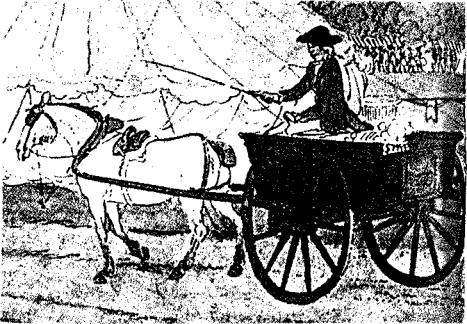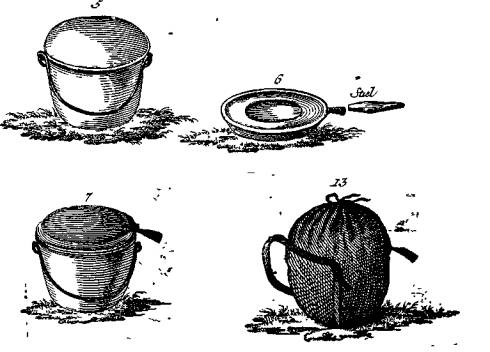[This is a follow-up to John Rees's article "'Properly fixed upon the Men ...' Linen Bags for Camp Kettles," Brigade Dispatch, vol. XXVII, No. 3 (Autumn 1997).)]
Among the problems to be resolved prior to the Continental Army's 1781 campaign season, was the most practicable method of transporting camp kettles. Quartermaster General Timothy Pickering wrote General Washington on 14 January 1781
I [previously] mentioned the provision of carriages ... for officers, & for... transporting the camp kettles of the troops. The two horse carts or tumbrils for both purposes may be constructed at Fishkill before the opening of the campaign.1
In a memorandum accompanying his 14 January letter to David Humphrey, aide to the commander in chief, Pickering commented on a 9 January general order directing that bags for carrying kettles be made from tents too worn out to be repaired:
If bags for camp kettles are made of the oldest tents, they will soon wear out, & tear with the slightest touch: Major Cogswell & I (before the publication of the Genl. Order) had proposed having one two horse waggon so constructed as to carry the kettles of a whole regt.2
In the main body of the 14 January letter Pickering expanded on his proposition:
I think the old tents if made into cases for the camp kettles will not answer your expectations. They have sometimes been made into forage bags but would not pay for the expense of making them up. Camp kettles ever seemed to me to be a disgusting incumbrance to the troops when they were required to carry them. If covered with close strong cases the difficulty would in a degree be obviated: but then they must be carried at their backs (in the German manner) & each furnished with a leathern belt or sling. If the troops carry their kettles & are attacked on their march, the kettles are of course thrown away. For these reasons I request your Excellency's attention to the method of carrying the kettles proposed in the memorandum I left with Mr. Humphrey's. One two horse tumbril, about six feet in the body in length, with higher sides than usual (like a coal cart) will carry all the kettles of a regiment, with one small bowl to each, until our kettles can be made with covers.3
Each tumbril was to carry 116 kettles and 18 axes. A 1780 British military picture includes a cart which fits Pickering's recommendations; a detail of the cart appears below.

A typical 18th-century cart or tumbril. Continental Army kettle carts would have been "about six feet in the body in length," with higher sides, and pulled by two horses. (Detail from 1780 painting of a camp kitchen in Hyde Park, attributed to Paul Sandby. David Chandler and Ian Beckett, eds., The Oxford Illustrated History of the British Army (Oxford and New York, 1994), between pp. 46-47.)
It is interesting that carts were proposed as an adjunct to kettle bags, and that "one small bowl" was to be included with each kettle. From examining equipment returns and issues, it seems that each six-man mess received only one bowl, possibly using it for food preparation and as a common eating dish, like a trencher.
As for the linen kettle bags, in February 1781 the commander in chief set aside Pickering's objection to using old tents, stating, "As these bags will have to bear little weight they are not liable to the same objection as the forage bags."4
A 1788 German military text includes illustrations of a kettle and bag, clarifying what Pickering meant by carrying the kettles "in the German manner".

Illustrations from a 1788 German military manual showing a camp kettle with detached frying pan (figures 5 and 6); kettle with cover on (figure 7); and kettle in carrying bag (figure 13). (Was ist Officier waehrend eines Feldzugs zu wissen noethig [trans., "What it is necessary for each officer during a campaign"] (Carlsruhe, 1788), plate 3.)
Notes
1. Timothy Pickering to Washington (with enclosed memorandum) 14 January 1781, George Washington Papers, Presidential Papers Microfilm (Washington, DC, 1961), series 4, reel 74.
2. Ibid.
3. Ibid.
4. Washington to Timothy Pickering, 10 February 1781, John C Fitzpatrick, ed, The Writings of George Washington from the Original Manuscript Sources 1745 1799, vol 21 (1937), p 206
My thanks to Chuck Beale for bringing the 1788 German military manual to my attention and to Donald Londahl-Smidt for translating the title